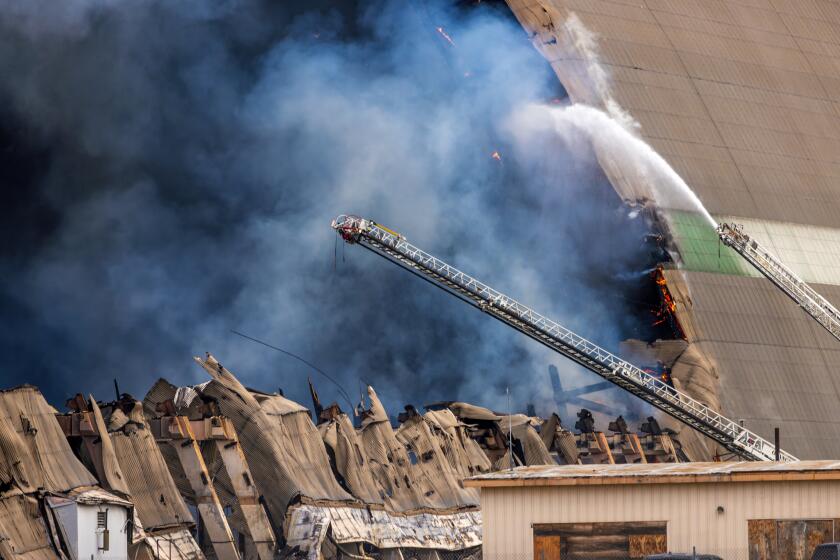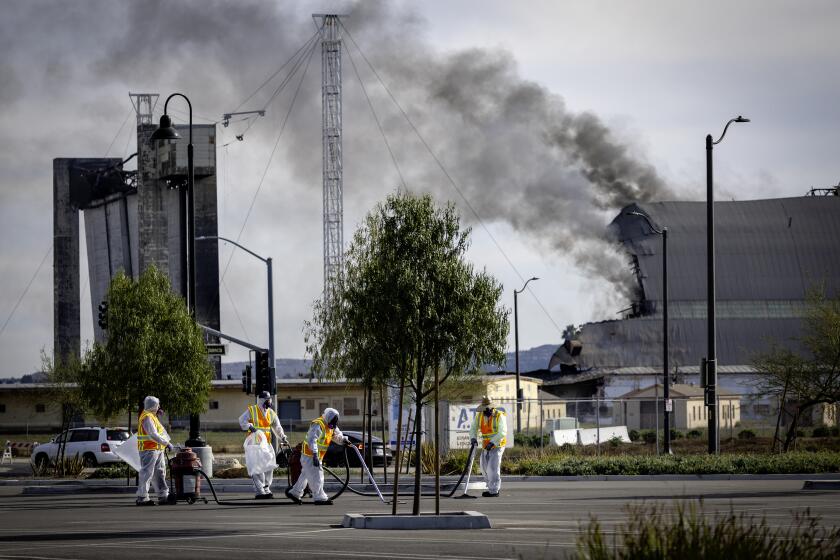Column: O.C. let its history rot. And the Tustin hangar fire is still burning
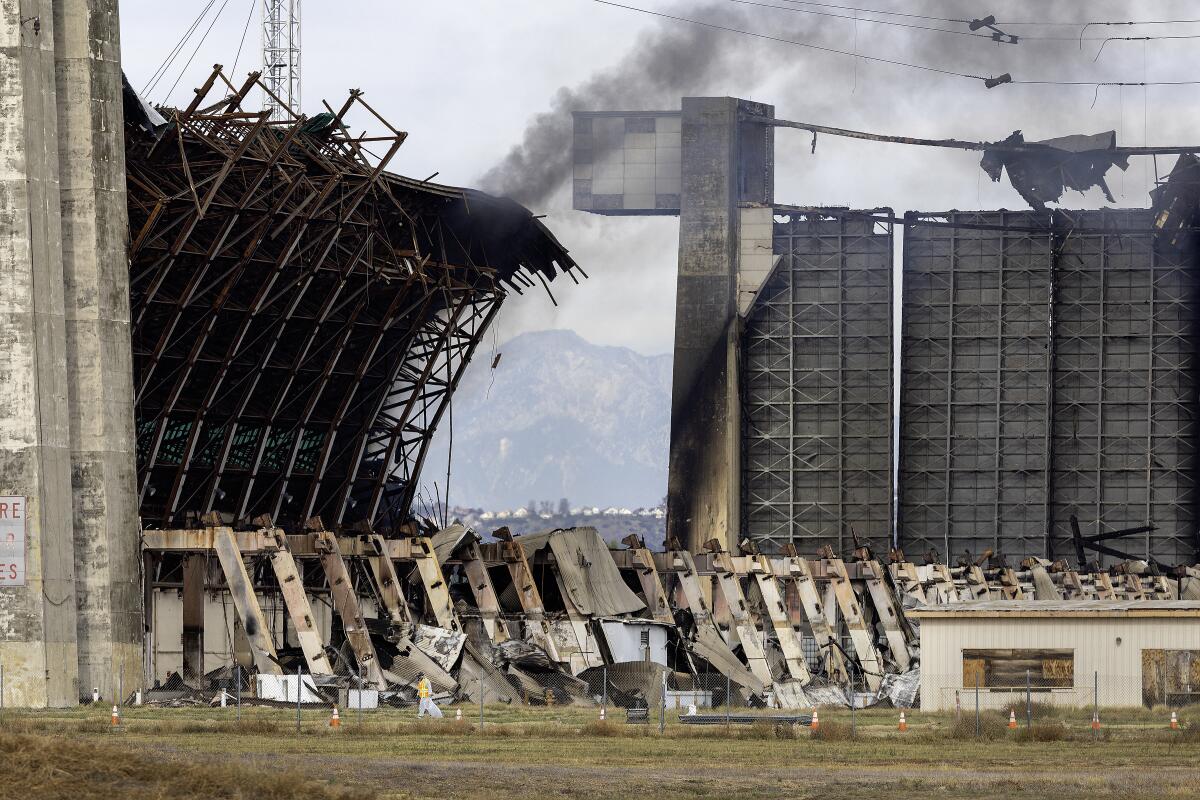
- Share via
Soon after Jude Francis moved into his new three-story Tustin townhouse in 2012, he attended an open house at his famous neighbor across the street: the city’s twin blimp hangars.
Seventeen stories tall, as wide as a football field and over 1,000 feet long, the wooden structures were built by the Navy in World War II to house dirigibles assigned to patrol the Pacific Coast. The Marines took over during the Korean War, storing military helicopters there until shutting down the facility in 1999.
By then, the hangars had become a beloved part of the Orange County landscape. For decades, they were the tallest buildings in the area, towering over a county that went from agriculture to suburbia to today’s metropolis of nearly 3.2 million people. The elegantly curved behemoths were visible by plane when landing at John Wayne Airport, from the 55 Freeway and for miles around.
They got the Hollywood treatment in films like “Austin Powers: The Spy Who Shagged Me” and the 2009 reboot of “Star Trek.” As surrounding neighborhoods developed, people got a better view of the fenced-off hangars, inspiring a new generation to fall in love with them and reigniting a question that city, county and military officials had long avoided:
What the hell would O.C. do with these white elephants?
To see a group of engineers gush over the blimp hangars at the Tustin Marine Corps Air Station, you would think the giant structures were the eighth wonder of the world.
Francis got a glimpse of the future when he and other residents attended the open house.
“They had a grand plan of how they were going to keep one and convert the other one into ice rinks and duck ponds,” said the tech consultant. “And I thought, ‘Oh, man, I’m going to live next to heaven.’”
We stood near his residence on a recent morning, looking onto a small version of hell.
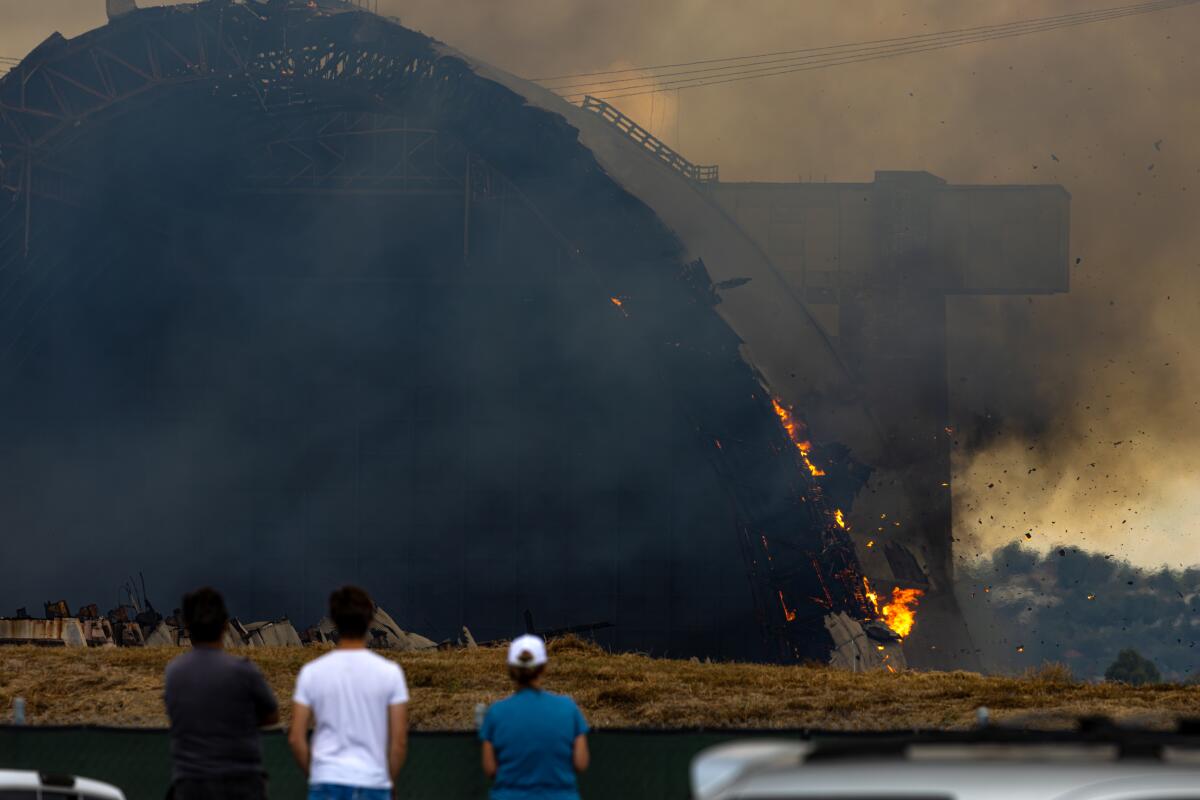
On Nov. 7, the North Hangar caught fire. Firefighters tried to put out the flames before deciding the sheer size of the structure made the task too dangerous. So they let it burn.
The hangar’s roof had completely collapsed. The top edge of the wall that once held it up was jagged and blackened. Worse, the inferno had spewed toxic substances like asbestos and nickel. Tustin schools were planning for remote learning through the week; eight nearby city parks were closed indefinitely.
A squadron of men wearing half-face respirators and covered in flimsy personal protective equipment from head to foot vacuumed every crack of the parking lot at nearby Veterans Sports Park. A plume of black smoke puffed up from the hangar’s ruins.
“This is horrible,” Francis said, shaking his head. His roof and gutters had been clogged with ash and debris. “They should’ve done something to develop it. They did nothing.”
Section after section of the historic north hangar at the now-defunct Marine Corps Air Station in Tustin collapse in a massive fire. Whatever remains will be demolished.
Next to us, Tom Hammer (“like the tool”) narrated videos that he was recording for his brother-in-law in Michigan. The retired fourth-grade teacher had driven up from San Clemente that morning with his black Chihuahua, Lola. His late father had served at the air station, as had his brother-in-law, who “was crying his eyes out,” Hammer said. “I was too busted up to come earlier. That’s my childhood there, burning up in flames.”
That was the first sentiment felt by many Orange County residents when news of the fire hit. The Tustin blimp hangars were our version of the Watts Towers: beloved architectural marvels of a bygone time that we drove past but rarely stopped to visit.
A week later, sadness had turned to anger.
Authorities still have no idea when the fire will die down, but demolition will be the next step. The hangar shouldn’t have suffered such an ignominious end.
It, along with its sibling, had stood empty for nearly 25 years, as local, county and Navy authorities dallied on what to do with them. Ever-changing plans were proposed to demolish both, keep one, or keep both, but money always got in the way. A section of the North Hangar’s roof collapsed in 2013, but Navy officials did little more than make sure it didn’t break any further. A 2017 Orange County grand jury urged action before the hangars decayed even more.
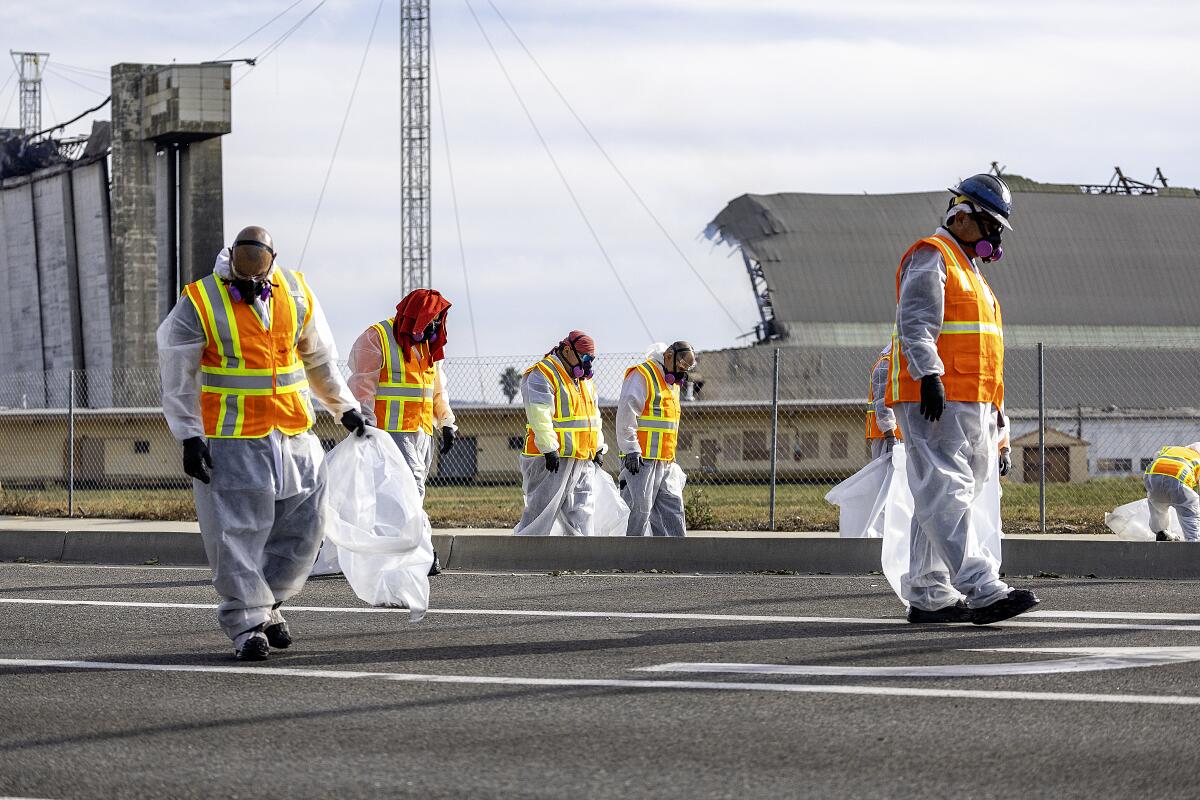
Hammer brushed his foot on the lawn and kicked up white shards. “Light this with fire, and it burns like a lantern,” he said.
“I hate to say it, but it had become an eyesore,” he continued. Near the bottom of the smoldering North Hangar were long-abandoned, boarded-up barracks surrounded by dead, overgrown grass. A flimsy fence was all that kept the public away.
“I’m old and fat, and I could get over that fence,” he joked, before getting serious and gesturing at Francis.
“From my father to me to this gentleman, we’ve been saying ‘Do something.’ Either fish or cut bait. Either do something about it or knock it down. People wanted to do something. But …”
He stopped to emphasize what he was about to say: “They never did anything with it.”
A former military hangar reignites in Tustin. After it burned last week, asbestos was discovered, closing schools and parks.
It’s usually about a minute-long drive from Veterans Sports Park down Valencia Avenue to the intersection of Kensington Park Drive, which offers the best place to see the other side of North Hangar. Street closures forced me to go through residential streets instead. People walked their dogs wearing masks and sunglasses while 18-wheelers followed by trucks flashing hazard lights rumbled past.
I parked in a nearby shopping plaza and made my way to the outdoor patio of a Sweetgreen, where Andirondack chairs sat empty. The downed hangar looked even worse from here.
The eastern wall was completely gone, revealing timber arches that reminded me of an exposed rib cage. The hangar’s huge door, which weighed over 100 tons, leaned off its steel rails and seemed a Santa Ana wind away from collapsing.
The obvious comparison would’ve been to a decomposed beached whale, or one of the destroyed alien spaceships from “Independence Day.” But my mind went to Percy Bysshe Shelley’s “Ozymandias,” the immortal poem about hubris told through the scene of a shattered statue.
Soon after the air station’s closure, Tustin officials allowed luxury neighborhoods with gag-inducing names like Levity at Tustin Legacy and Amalfi Apartments to spring up near the hangars. Meanwhile, the U.S. Navy sent letters to local homeowners associations two years ago warning that the groundwater under their homes might hold toxic chemicals from the military past.
The destroyed North Hangar represents the folly of Orange County, a place that romanticizes its past while letting it rot if there’s no profit to be made. Now, residents are suffering.
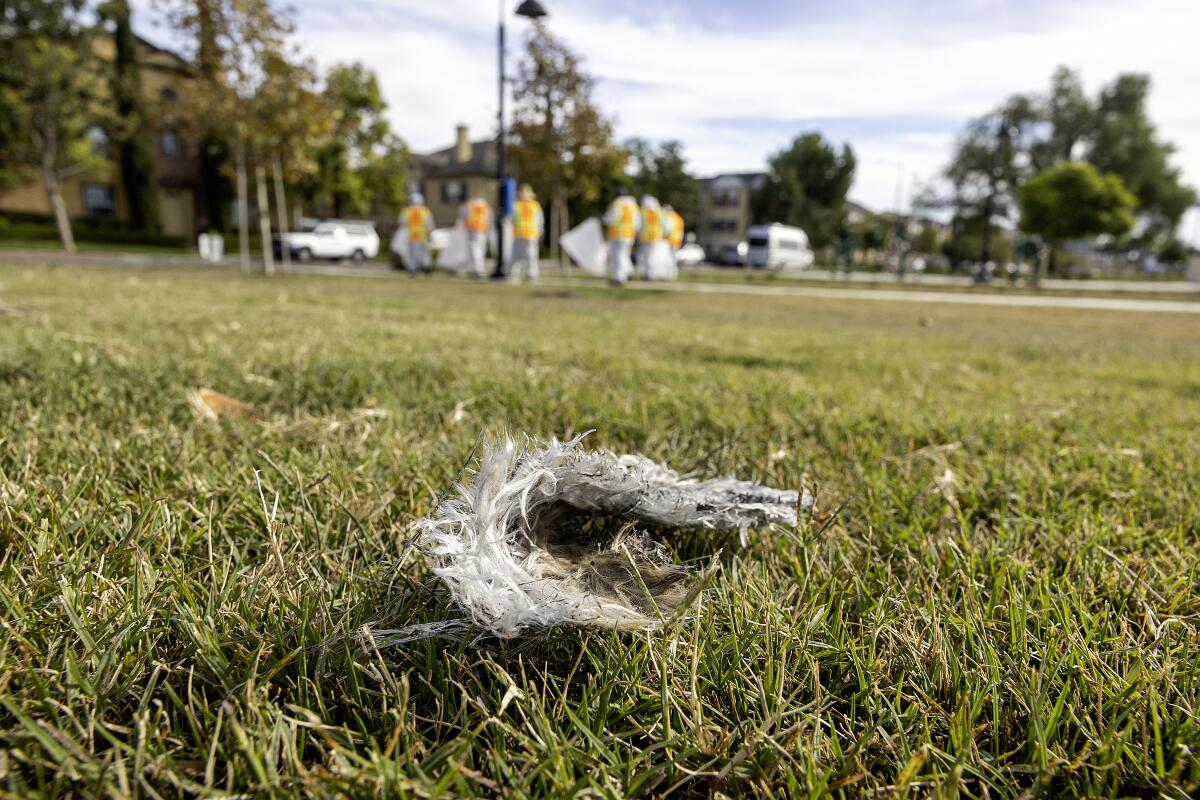
The air began to sting my eyes and throat as Irvine resident Rebecca Flores and her son, Christian, took photos of the scene.
“This is a worst-case scenario,” she said. “No one knows what’s going to happen.”
“They’re not holding press conferences. They’re not doing much of anything,” said Christian, who works at a nearby retailer and said his colleagues were afraid to show up. “They’re just letting it burn.”
Before us, a row of workers with vacuums slowly walked down Valencia like crime scene investigators. Next to them was Legacy Magnet Academy, a middle and high school built in the style of the hangars. It was closed.
Rebecca kept brushing debris from Christian’s shoulders. We all wore facemasks. Hers bore a Stars and Stripes-style logo of The Punisher, a Marvel superhero popular among law enforcement supporters.
“I don’t like wearing masks,” Rebecca said, before offering a laugh. “But I’m wearing one for this.”
More to Read
Sign up for Essential California
The most important California stories and recommendations in your inbox every morning.
You may occasionally receive promotional content from the Los Angeles Times.
